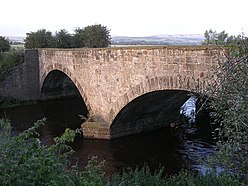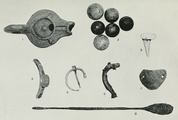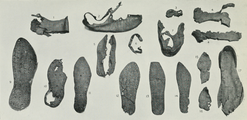Balmuildy
| Balmuildy | |
|---|---|
 Balmuildy Bridge, modern road bridge near the Glaswegian section of the Antonine Wall | |
| Place in the Roman world | |
| Province | Britannia |
| Structure | |
| — Stone structure — | |
| Location | |
| Town | Glasgow |
| Country | |
| Site notes | |
| Condition | Ruined |
Balmuildy is the site of a Roman fort on the Antonine Wall in Scotland.[1] It is one of only two forts on the Antonine Wall to have been found with stone ramparts; the other is Castlecary.[2] A digital reconstruction of the fort has been created.[3]
Location[edit]

The fort is located in Glasgow, west of Bishopbriggs and east of Bearsden, south of the River Kelvin and north of the Forth and Clyde Canal. The fort was just south of the River Kelvin and north-west of Easter Balmuildy Farm which locates it within Glasgow City Council's borders, close to East Dunbartonshire to the east.[4] Its neighbouring forts are Bearsden to the west and Cadder to the east although there are intermediate fortlets at Summerston to the west and Wilderness Plantation to the east.[5] See map below for details.
Context[edit]


Balmuildy Castro was constructed between 142 and 154 AD at the order of Roman Emperor Antoninus Pius.[7] Quintus Lollius Urbicus, governor of Roman Britain at the time, initially supervised the effort. It was one of sixteen forts built to support the Antonine Wall, with small fortlets between them; troop movement was facilitated by a road linking all the sites known as the Military Way. Antoninus Pius never visited Britain, whereas his predecessor Hadrian did. Pressure from the Caledonians may have led Antoninus to send the empire's troops further north. The wall, and Balmuildy, was abandoned only eight years after completion, and the garrisons relocated back to Hadrian's Wall. In 208 Emperor Septimius Severus re-established legions at the wall and ordered repairs; this has led to the wall being referred to as the Severan Wall. The occupation ended a few years later, and the wall was not occupied again.[8]
Most Roman forts along the wall held garrisons of around 500 men.[9] Larger forts like Castlecary and Birrens had a nominal cohort of 1,000 men[10] but probably sheltered women and children[11] as well, although the troops were not allowed to marry.[12] It is likely that there were large communities of civilians around the site.[13]
Descriptions and finds[edit]

The site was excavated by Steuart Napier Miller who wrote about it in his 1922 volume: The Roman fort at Balmuildy (Summerston, near Glasgow) on the Antonine Wall.[19] Sir George Macdonald also described the site in the 1934 in The Roman wall in Scotland.[20] The related site of Summerston was written about by J. M. Davidson in 1937.[21]
An altar to Fortuna was found in one of the fort's bath houses similar to the one found at Castlecary.[22] There was also an altar dedicated to Mars found along with some statues.[23] A dedication to a building by the Second Legion was found although the stone had been repurposed by farmers.[24] Fragments of another stone by the same legion were also discovered.[25] Part has been scanned and a video produced.[26] All of these finds are now in the Hunterian Museum in Glasgow.[27] Other discoveries include: a door hinge plate,[28] a terracotta bath house drainpipe,[29] a holdfast to stick tiles to the bath house wall,[30] a perfume pot,[31] an unguent pot,[32] a Samian ware platter,[33] and a clay cheese press.[34] An oil lamp[35] and a surgical probe[36] have also been scanned to video.
- Samian ware
- unglazed ware
- wee objects
- stone objects
- leather footwear
References[edit]
- ^ "Balmuildy". CANMORE. Royal Commission on the Ancient and Historical Monuments of Scotland. Retrieved 18 November 2017.
- ^ "BALMUILDY: FORT" (PDF). Frontiers of the Roman Wall. Retrieved 25 November 2017.
- ^ "Reconstruction of Balmuildy Fort". 11 May 2018. Retrieved 19 May 2018.
- ^ "Balmuildy". OpenStreetMap. Retrieved 18 November 2017.
- ^ "OS 25 inch map 1892–1949, with Bing opacity slider". National Library of Scotland. Ordnance Survey. Retrieved 12 October 2017.
- ^ "Statue of Mars Ultor, Balmuildy". 11 May 2018. Retrieved 19 May 2018.
- ^ Robertson, Anne S. (1960) The Antonine Wall. Glasgow Archaeological Society. ISBN 9780902018143 p. 7.
- ^ John), Breeze, David J. (David (2006). The Antonine Wall. Historic Scotland. Edinburgh: John Donald. ISBN 9780859766555. OCLC 65469031.
{{cite book}}: CS1 maint: multiple names: authors list (link) - ^ "Soldier". Frontiers of the Roman Empire. Retrieved 21 October 2017.
- ^ Miller, S. N. (1952). The Roman Occupation Of South Western Scotland Being Reports Of Excavations And Surveys Carried Out Under The Auspices Of The Glasgow Archaeological Society By John Clarke, J. M. Davidson, Anne S. Robertson, J. K. St. Joseph, Edited For The Society With An Historical Survey By S. N. Miller. Glasgow: Robert Maclehose & Company Limited. OCLC 561168405. Retrieved 11 October 2017.
- ^ "Children". Frontiers of the Roman Empire. Retrieved 21 October 2017.
- ^ "Roman child's leather shoe". A History of the World. BBC. Retrieved 17 October 2017.
- ^ Rohl, Darrell, Jesse. "More than a Roman Monument: A Place-centred Approach to the Long-term History and Archaeology of the Antonine Wall" (PDF). Durham Theses. Durham University. Available at Durham E-Theses Online ref: 9458. Retrieved 14 October 2017.
{{cite web}}: CS1 maint: multiple names: authors list (link) - ^ "RIB 2192. Honorific Building Inscription of the Second Legion". Roman Inscriptions of Britain. Retrieved 18 November 2017.
- ^ "Fragment of a building tablet, Balmuildy". 11 May 2018. Retrieved 19 May 2018.
- ^ "RIB 2191. Honorific Building Inscription of the Second Legion". Retrieved 5 May 2018.
- ^ Macdonald, Sir George (1934). The Roman wall in Scotland, by Sir George Macdonald (2d ed., rev., enl., and in great part rewritten ed.). Oxford: The Clarendon press. pp. 404–405. Retrieved 11 October 2017.
- ^ "Commemorative Stone Fragment of the Second Legion, Balmuildy". 3 July 2015. Retrieved 25 November 2017.
- ^ Miller, Steuart Napier (1922). The Roman fort at Balmuildy (Summerston, near Glasgow) on the Antonine Wall. Glasgow: Printed for the Glasgow Archaeological Society by Maclehose, Jackson. Retrieved 19 November 2017.
- ^ Macdonald, Sir George (1934). The Roman wall in Scotland, by Sir George Macdonald (2d ed., rev., enl., and in great part rewritten ed.). Oxford: The Clarendon press. pp. 312–324. Retrieved 11 October 2017.
- ^ Robertson, Anne S.; Miller, S. N. (1937). The Roman Occupation Of South Western Scotland. Glasgow: Robert Maclehouse Com.ltd The University Press Glasgow. Retrieved 19 November 2017.
- ^ "RIB 2189. Altar dedicated to Fortuna". Roman Inscriptions of Britain. Retrieved 18 November 2017.
- ^ "RIB 2190. Altar dedicated to Mars". Roman Inscriptions of Britain. Retrieved 18 November 2017.
- ^ "RIB 2191. Honorific Building Inscription of the Second Legion". Roman Inscriptions of Britain. Retrieved 18 November 2017.
- ^ "RIB 2192. Honorific Building Inscription of the Second Legion". Roman Inscriptions of Britain. Retrieved 18 November 2017.
- ^ "Fragment of a building tablet, Balmuildy". 11 May 2018. Retrieved 19 May 2018.
- ^ "building tablet of the Second Legion (in five parts; these 3 pieces – fragments of lettering)". Hunterian Museum Archaeology & Ethnography Collections: GLAHM F.6. University of Glasgow. Archived from the original on 1 December 2017. Retrieved 18 November 2017.
- ^ "Hinge plate for door, Balmuildy". 28 May 2015. Retrieved 25 November 2017.
- ^ "Teracotta Drainpipe, Balmuildy". 28 May 2015. Retrieved 25 November 2017.
- ^ "T-shaped holdfast, Balmuildy". 28 May 2015. Retrieved 25 November 2017.
- ^ "Perfume pot, Balmuildy". 7 September 2015. Retrieved 25 November 2017.
- ^ "Unguent Pot, Balmuildy". 31 August 2015. Retrieved 25 November 2017.
- ^ "Samian ware platter, Balmuildy". 10 August 2015. Retrieved 25 November 2017.
- ^ "Cheese Press, Balmuildy". 3 August 2015. Retrieved 25 November 2017.
- ^ "Oil Lamp, Balmuildy". 11 May 2018. Retrieved 19 May 2018.
- ^ "Surgical Probe, Balmuildy". 11 May 2018. Retrieved 19 May 2018.
- ^ "RIB 2189. Altar dedicated to Fortuna". Roman Inscriptions of Britain. Retrieved 26 May 2018.
- ^ "RIB 2190. Altar dedicated to Mars". Roman Inscriptions of Britain. Retrieved 26 May 2018.


 French
French Deutsch
Deutsch









